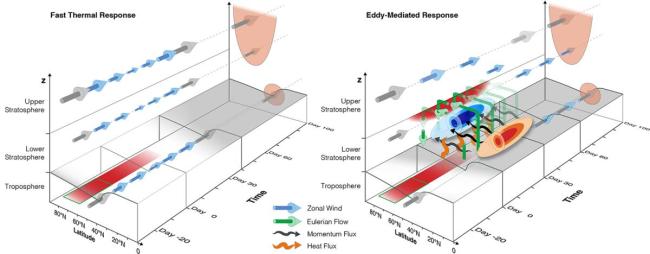How short-term Arctic warming can lead to delayed stratospheric circulation responses
Rapid warming of the Arctic and declining sea ice cover have the potential to affect climate far from the Arctic. Some of the heat accumulating in the Arctic Ocean can escape to the atmosphere, which has been suggested to influence the large-scale circulation, especially in the stratosphere and in midlatitudes.
Several recent studies suggest that sea ice loss in late fall or early winter can trigger conditions that favor the upward propagation of planetary waves into the stratosphere, which weakens the stratospheric polar vortex. A weaker polar vortex can then influence the troposphere, weakening the North Atlantic Oscillation and modulating surface temperatures throughout the midlatitudes. However, observations and modeling studies do not agree on how the polar stratosphere responds to anomalous Arctic heat fluxes, and how they in turn affect the midlatitude troposphere. These discrepancies point to an incomplete understanding of the mechanism involved.
A recent study published in the Journal of Atmospheric Science uses large ensembles of an idealized general circulation model to identify how and on what timescales the atmospheric circulation responds to short-term surface heat flux anomalies in high latitudes. The study finds that the ensemble-mean circulation response is approximately linear in the amplitude of the heat fluxes and is insensitive to whether the forcing is zonally asymmetric or symmetric, that is, whether stationary waves are generated or not.

Estimates of interannual variability from new and published coral δ18O records from the northern Line Islands. a) Relative ENSO variance changes in fossil coral δ18O calculated from the standard deviation of sliding 20-year windows of monthly coral δ18O data that was first 10-year high-passed, then 13-month running averaged, plotted as the average standard deviation of each coral timeseries relative to the 1987-2007 CE intervals of corresponding modern spliced coral δ18O timeseries from each site (the dashed ‘zero’ line). Coral data originate from Palmyra (red) (Cobb et al. 2003), Fanning (blue) (Cobb et al. 2013), and Kiritimati (green) (Cobb et al. 2013; McGregor et al. 2013a; and this study). The bars represent the full range of interannual variability in 20-year windows of each coral sequence. Coral timeseries of <20 years are plotted with open circles. Coral timeseries from 20 years < length < 320 years are plotted linearly with size where smaller dots are shorter sequences. The gray box denotes the full range of ENSO variability from the modern spliced coral records in 20-year windows, as reflected in panel (b). b) Same as in (a) but for the modern spliced coral δ18O timeseries for each island (Palmyra: 1886-2007 CE; Fanning 1949-2005 CE; Kiritimati Island: 1939-2016 CE). Colors as in (a). Click image to enlarge.
Further, the authors decomposed the circulation response into a fast thermal response and a slow eddy-mediated response (see left and right panel in figure). The fast response is a result of thermal wind balance – for example, an episodic polar warming (increase in surface heat fluxes) weakens the meridional temperature gradient, which requires a deceleration of the zonal wind aloft (left panel). This zonal wind anomaly decays on (tropospheric) radiative time scales.
The slow eddy-mediated response arises through changes in upward wave activity fluxes in mid-latitudes, which are also related to the meridional temperature gradient. As illustrated in the right panel, a weaker surface temperature gradient reduces the upward wave activity flux into the stratosphere in midlatitudes, and it also leads to weaker horizontal wave activity fluxes (momentum fluxes) in the mid-latitude stratosphere. The weakened pattern of eddy momentum flux convergence and divergence is balanced by a weakened Eulerian mean circulation in the stratosphere, with less rising motion in the mid- and high-latitude stratosphere (shown as anomalous subsidence in the right panel).
This work demonstrates how episodic surface warming in the Arctic can lead to delayed responses in the stratosphere that persist for about two months, even in the absence of stationary waves. The authors note that the outlined eddy-mediated mechanism differs from Sudden Stratospheric Warmings, but still results in a weakened stratospheric circulation. The late effects in the troposphere, in response to the stratospheric adjustments, are weak and only discernible through the large ensemble used in the study.
Atmospheric Circulation Response to Short-Term Arctic Warming in an Idealized Model (Journal of the Atmospheric Sciences)
Topics
- Modeling
- Arctic
- Air-Sea
- Internal Variability
